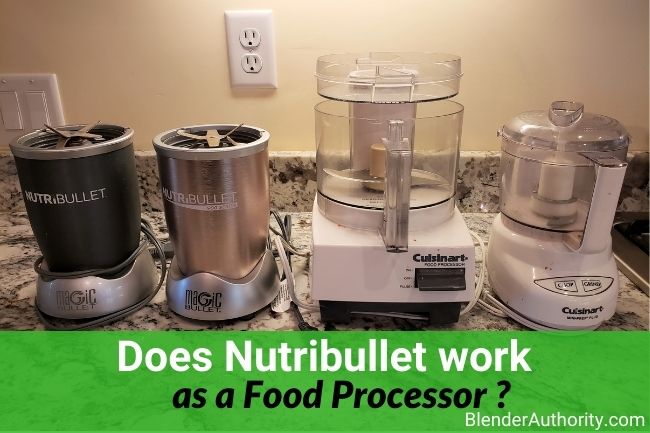How to use Nutribullet as a Food Processor

After using Nutribullet blenders for many years and answering a lot of Nutribullet questions, one of the difficult questions I get is “Can a Nutribullet be used as a food processor ?”
The answer is”it depends”. Let me explain…..
Nutribullet vs Food Processors
A food processor is designed with a flat clopping blade and wide bowl to push out the ingredients as it chops them up. Food processors are ideal for chopping, dicing, milling and evenly moving the ingredients around.
Whereas, Nutribullet is designed to operate like a standard blender in that the blade pulls the ingredients down to the bottom and creates a vortex to puree the ingredients.
You can use a Nutribullet to chop and dice certain ingredients without pureeing by “pulsing” the blender on/off and not using liquids.
The main drawback of Nutribullet or any blender over a typical food processor is that a blender blade doesn’t push the ingredients out and up which can make it hard to evenly process the ingredients.
Don’t get me wrong though, the Nutribullet is great for certain food processing tasks if you have reasonable expectation that it won’t completely replace the capability of a food processor.
The advantage of a blender though is that you can puree ingredients to make things like soups, dressings, and dips.
Evolution of Nutribullet Blenders
The traditional “bullet” shaped jars of Nutribullet blenders like the Magic Bullet and namesake Nutribullet product line are limited in the range of food processing tasks that they can do as I explained above.
Magic Bullet blender is the least powerful model with its limited ability to chop or dice cooked or soft ingredients.
The higher powered Nutribullet product line has a more powerful motor and different blade design that allows for you to chop, dice, and puree a wider range of ingredients.
To dice or chop you just use twist the Nutribullet on/off for a few seconds at a time to pulse the ingredients and keep them moving around.
In recent years, Nutribullet expanded by adding a food processor model called the Veggie Bullet. It has some limitations which I detail in this review.
The Veggie Bullet is strictly for food processing so I am assuming you are focused on Nutribullet’s blender models so lets get into the specifics of what you can do….
What Can a Nutribullet Do ?
As mentioned above, the Nutribullet is ideal for blending and pureeing but it does great for certain processing tasks in small batches.
Examples of Nutribullet food processing tasks that I do are :
- Chop up seeds and nuts.
- Dice up onions, tomatoes, spices for salsa.
- Mill flaxseed and oats into flour.
- Make homemade pesto (basil, raw garlic, olive oil, walnuts, and spices to make homemade dairy-free pesto).
- Grind up spices
- Grind up coffee (Tip- keep a separate Nutribullet jar just for coffee grinding as the oils can leave a strong coffee smell in the jar).
Here is an example of grinding Flaxseed with a nutribullet :

Limitations of Nutribullet
Nutribullet isn’t ideal for making nut butters and large batches. Also it will only mill certain ingredients for making flours.
Nutribullet is not great for making Nut butters. Nut butters can be really thick so you have to stop blending and open the lid to mix the ingredients around. You are better off using a blender with a tamper and lid that opens on top. See related post: Nut Butters Blenders
You can’t mix or blend hot ingredients as the Nutribullet container is sealed and has no way to release pressure from steam.
The Nutribullet works best with making small batches as you need to allow the blade to move the dry ingredients around even dicing and chopping.
Final Thoughts
Overall a Nutribullet blender is good for certain food processing tasks. As long as you do it in smaller batches because of Nutribullet’s blade design then you can get similar results as a small food processor (like the one in the picture at the top of this post).
A large food processor is a better solution though if you want more versatility in ingredients, milling flours, thicker recipes, and larger batches.

